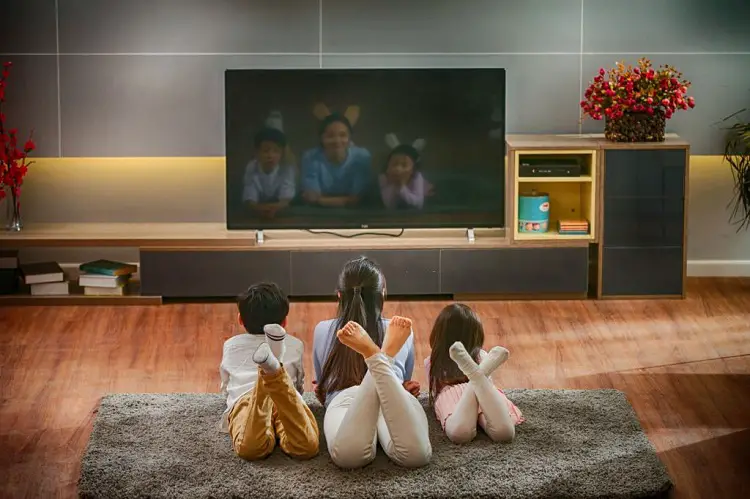The eye-catching images and vivid sounds in Tv commercials often attract babies and children between the ages of 2-11 years.
It is important to note that, even though they appear to be interested in these commercials, their understanding of the content is quite limited at such a tender age, and their responses are based on sensory stimulation- rather than a clear understanding of the advertisement’s message.
If you’ve been wondering why do babies like Tv commercials, here are some reasons to help you understand.
- The bright and colorful visuals in commercials can be highly stimulating for infants still developing their visual perception skills.
- Commercials often feature catchy jingles or music, which can appeal to babies just starting to explore the world of sound.
- The fast-paced nature of commercials can hold a baby’s attention, as they are constantly presented with new and exciting images and sounds.
However, parents need to monitor their baby’s exposure to television and ensure that they are not being exposed to too much screen time at a young age.
Read on to learn more about the effects of too much screen time exposure and tips on managing it.
Why Do Babies Like Tv Commercials?
Bright colors, vivid images, and catchy sounds of television commercials often attract babies and young children.
They could watch different commercials all day long as to other boring Tv shows.
Interestingly, as attracted as they seem to be to these shows, they have little to no understanding of what they watch, and their responses to these contents rely on sensory stimulation.
Here are five reasons babies seem to like Tv commercials
1. Visual Stimulation
Tv commercials often contain bright, contrasting colors, rapidly changing scenes, and animated characters, all visual stimuli.
Babies are naturally attracted to these visual stimuli because they help capture their attention and stimulate their developing visual senses.
2. Auditory Stimulation
Ads often incorporate upbeat music, jingle sounds, and sound effects that can delight children. Auditory experiences combined with visual elements can create multi-sensory appeal.
3. Movements and Action
Newborns are attracted to movement and act instinctively. Ads often feature fast-paced scenes, moving characters, and a variety of activities that can capture the attention of young children.
4. Repetition and Predictability
Many commercials use predictable patterns and repetitions, which can be more comforting to children as they begin to recognize familiar elements. Repetition gives them a sense of control and familiarity.
5. Short Attention Span
Newborns have short attention spans and can lose interest quickly. Television commercials which are often short and change frequently, correspond to their limited ability to focus on a single activity over a long period.
According to research, toddlers prefer ads for diapers, toys, and snacks even more than Tv shows made for children.
And it’s because the advertising industry knows the content that interests your kids.
Advertising is a form of short entertainment, and toddlers have a short attention span at the age of 2 years.
The 30 seconds of flashing lights, funny sounds, and colors are designed to draw their attention within the time the ads last.
Today, companies spend about $17 billion annually on marketing to children rather than the $100 million spent in previous years (1983).
However, research shows that young children cannot distinguish between advertisements intended for them and other programs and may not realize the persuasive intent of an ad until age 8.
It is important to note that while some infants may show interest in television commercials, excessive screen time, including television commercials, is often not recommended for young children.
The American Academy of Pediatrics (AAP) recommends avoiding screen time for children under 18 months, except for video chat.
Children aged 18 to 24 months participate in high-quality educational programs under the guidance of their parents.
Involving children in interactive and age-appropriate activities such as reading, playing with toys, and face-to-face interactions is often more beneficial o a child’s overall development than physical contact.
What Are The Impacts Of Advertising On Kids?
Ads can have positive and negative effects on children, depending on the child’s content, context, and age. Here are some important points to consider:
Positive Effects
Education and Information
Some advertisements, especially for toys, books, or educational programs, can provide children with valuable information and learning opportunities.
Creativity and Imagination
Beautifully and creatively designed ads can stimulate children’s imagination and creativity. They can inspire children to think creatively and explore new ideas.
Cultural Exhibition
Advertising can introduce children to different cultures, traditions, and lifestyles, promote diversity and broaden their view of the world.
Healthy Habits
Ads promoting healthy food, exercise, and positive behavior can help children better understand healthy lifestyle choices.
Negative Effects
Misleading Information
According to Dr. Yamuna, many advertisements are deceptive.
She provides a few examples, such as a milk food ad that promises children who drink it will grow taller than those who consume alternate beverages.
However, this claim is false since genetic factors primarily determine height, and no healthy drink can alter it.
Cereal ads suggest that if a child eats their product, they will not require any other food for the day.
However, it is important to note that these cereals are intended for breakfast only and provide only 10%-15% of the recommended daily dietary intake.
The influence of these ads on children can blur the distinction between fantasy and reality.
Materialism and Consumerism
Overexposure to advertising can foster a materialistic mindset, causing children to prioritize material possessions and associate happiness with product purchases.
Unrealistic Expectations
Ads often depict idealized images that can create unrealistic expectations about beauty, appearance, and lifestyle, leading to body image problems and low self-esteem.
Behavioral Influences
Children, especially young children, are susceptible to the persuasive tactics used in advertising.
This can lead to bullying or manipulative power, where children force parents to buy products they see advertised, which may not always be appropriate or necessary.
Game Marketing
Some ads associate the product with the game, potentially devaluing the unstructured and imaginative playtime.
Privacy and Online Advertising
With The rise of digital media, children’s online activities can be tracked for targeted advertising, raising privacy and data security concerns.
Violent and Inappropriate Content
Ads, especially in video games or online platforms, may contain violent or inappropriate content unsuitable for children.
Tips On How To Manage The Effects Of Advertising On Kids

Parents and guardians play an important role in mitigating the potential negative effects of advertising on children.
Here are some tips to help you curb the negative effects of advertising on kids:
1. Media Education
Teaching children about the persuasive purpose of advertising and helping them develop critical thinking skills can help them better understand and appreciate the messages they encounter.
2. Follow-up and Support
Parents should monitor their children’s content and guide them to make healthy media choices. Watching and discussing ads together can create conversation opportunities.
3. Limit Screen Time
Setting reasonable limits on device time and ensuring a balance between activities such as playing outdoors, reading, and creative play can reduce the overall impact of advertising.
4. Promote Values
Parents can emphasize values such as empathy, kindness, and gratitude rather than materialism, helping children develop a more balanced outlook.
Parents and guardians may advocate for stricter regulations on advertising targeted to children, both on traditional media and online platforms.
Overall, a proactive and well-informed approach to media use and open communication with children can help reduce the potential negative impact of advertising and promote a healthier media environment.
Read Also: Why Do Babies Like TV Remotes – Tips To Help You Cope
How Much Screen Time Is Too Much For Kids?
The appropriate amount of screen time for kids varies depending on their age and individual circumstances.
Too many commercials are not age-appropriate and can expose babies to inappropriate images and messages.
This can affect their emotional well-being and lead to behavioral problems later in life.
Therefore, it is important to limit a baby’s exposure to TV commercials and ensure that they are watching age-appropriate content.
The American Academy of Pediatrics (AAP) provides general guidelines for screen time.
Still, it’s important to note that these recommendations are not rigid rules and should be adapted to each child’s specific needs and developmental stages.
Here are some AAP guidelines:
Infants (0-18 months): The AAP recommends avoiding screen time (except for video chatting) for children under 18. Instead, focus on interactive activities, reading, and face-to-face interactions.
Toddlers (18-24 months): Limited screen time can be introduced for high-quality educational content under parental guidance.
Parents should choose age-appropriate media, co-view with their child and use screen time to enhance learning and engagement.
Preschoolers (2-5 years): Limit screen time to 1 hour of high-quality educational programming daily. Co-viewing and discussing content with children can help reinforce learning and critical thinking.
School-Age Children (6 years and above): Parents should establish consistent limits on screen time and the types of media their children consume.
The focus should be balancing screen time with other healthy activities like physical activity, social interactions, and sleep.
Additional Considerations
Quality over Quantity
The quality of content is more important than the amount of screen time. Choose educational, age-appropriate, and non-violent programs or apps that align with your child’s interests and learning goals.
Sleep
Excessive screen time, especially before bedtime, can integer with sleep. Establish a screen-free zone in bedrooms and avoid screens for at least an hour before bedtime.
Physical Activity
Ensure children have ample time for physical activity and outdoor play, as excessive screen time can lead to sedentary behaviors and health issues.
Social Interactions
Screen time should not replace face-to-face social interaction. Encourage children to interact with family, friends, and peers in real-world interactions.
Content Monitoring
Regularly review the content your child is consuming to ensure it aligns with your family’s values and is appropriate for their age and maturity.
Parental Role Modelling
Parents should be mindful of their screen time habits as children often mimic their parent’s behaviors.
Read Also: 3 Friendly Video Games To Play While Pregnant
Conclusion
The suggestions above answer the question of why do babies like Tv commercials.
However, remember that babies’ minds are like blank sheets. They tend to register whatever they’re exposed to, so be mindful of the content they consume because ads can have a lasting impression on the kids, no matter how short.
